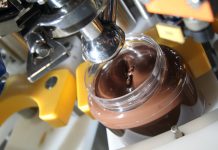Powdered sugar or granulated sugar
The mass conveniently processed in the mixers now passes to the veritable phase of  refining. Generally, this process can be performed by two different methodologies: using powdered sugar or granulated sugar. In the first case we will proceed directly in a “five-cylinder” (one stage process), while in the second case there will be a first step for roughing in a “two-cylinder” and then in the “five-cylinder” (two-stage process). It should be remembered that, after cocoa, sugar is the most important component of chocolate, since it is at least 40-50% of the composition. From the choice of its physical state depends the adoption of refining technology by single stage or two stages: in practice we must decide if we will proceed by pre-refining or not. In case we want to exclude pre- refining, it will be necessary to partially reduce the particles in granulated sugar, (pre)-grinding it so that at the end of the process it will have very low quantity of fine particles (sub-fines) so not to affect the rheological characteristics of the product that will be refined subsequently: more fine particles we have, more fat will be necessary to laminate the chocolate. During grinding it is necessary to pay attention to sugar which is thermo-sensitive, so there can be the risk of spontaneous combustion and explosions. Instead if we pre-refine, the chocolate mass, after being prepared in the mixer, will pass through two or three cylinders that will reduce the size of the particles making them homogeneously suitable for refining into the “five-cylinder”. The resulting mass will be denser than the one coming from the mixer and it will be conveyed to the next refining stage. From a physiological point of view, human taste buds allow particles not smaller than 20–25 µm to be discriminated, which means that only particles with bigger dimensions can be recognized as “grains”, giving roughness sensation, which is a well-known feature of not perfectly refined chocolates. So, apparently, from the technological aspect, one should ensure that all chocolate particles have a maximum size less than 25 microns. However, the taste sensation doesn’t depend only on the size of the single particles, but also on their uniformity of distribution. Refining machines are, in essence, machines formed by a certain number of cylinders, from three to five, initially made of granite, currently made of centrifuged steel, coupled in longitudinal direction, with devices that, applying forces at the cylinders’ ends, are designed to delimit the distance between them (lights) when the product passes through. The work surface – refining table – is in practice determined by the cylinder’s length. Water – usually cold or mild – circulates inside the cylinders with the purpose to balance the heat generated by the friction caused by their movement and by their action on the product. The mass passes from one cylinder to another, from the lower to the respective upper cylinder, running them all until its pouring out, which occurs by scraping the upper cylinder. The mass inside a refining machine must be perfectly homogeneous so that its passage through the cylinders is constant, in other words, some phenomena such as fat separation that causes discontinuity in the product processing must be avoided. Generally, the fat content of the masses to be refined ranges from 22 to 30%, which means that, from similar grain sizes, the rheological characteristics of the same may vary from the condition of “dry sand” to very liquid dough. During refining, the product’s sliding characteristics vary considerably, to the point that at its pouring out, we get a dusty-looking product. During refining, grinding is determined both by crushing, due to the forces that delimit the opening of the product’s passage between the single pairs of cylinders, and by the fact that these rotate at increasing speeds from first to last (from the bottom upwards), generating considerable cutting efforts that, when they are raised up by the very small amount of product on which they apply, they surpass the power of the particles’ internal cohesion and cause their breakage. Transfer of the product from a cylinder to another, is practically due to the different existing speed, which in turn, must be carefully calibrated to allow the passage of the whole mass that has crossed the grinding opening. This aspect highlights how the refining process is essentially controlled by the speed ratios existing between the refining machine’s cylinders and by the forces applied on the cylinders that delimit the grinding opening. In conclusion, the refining process can be described through the description of the interaction phenomena existing between the mechanical settings of the machine, by defining the applicable parameters as – for example – rotation speed, the entity of the forces that delimit the opening and the rheological characteristics of the product to be processed, in their turn determined by composition. A further control parameter that regulates the machine’s operating is given by the cylinders’ temperature, which causes, in practice, an easy or less easy cohesion of the product on the same cylinders: if we increase the cylinders’ temperature we will reduce the chocolate’s adhesion on them.
refining. Generally, this process can be performed by two different methodologies: using powdered sugar or granulated sugar. In the first case we will proceed directly in a “five-cylinder” (one stage process), while in the second case there will be a first step for roughing in a “two-cylinder” and then in the “five-cylinder” (two-stage process). It should be remembered that, after cocoa, sugar is the most important component of chocolate, since it is at least 40-50% of the composition. From the choice of its physical state depends the adoption of refining technology by single stage or two stages: in practice we must decide if we will proceed by pre-refining or not. In case we want to exclude pre- refining, it will be necessary to partially reduce the particles in granulated sugar, (pre)-grinding it so that at the end of the process it will have very low quantity of fine particles (sub-fines) so not to affect the rheological characteristics of the product that will be refined subsequently: more fine particles we have, more fat will be necessary to laminate the chocolate. During grinding it is necessary to pay attention to sugar which is thermo-sensitive, so there can be the risk of spontaneous combustion and explosions. Instead if we pre-refine, the chocolate mass, after being prepared in the mixer, will pass through two or three cylinders that will reduce the size of the particles making them homogeneously suitable for refining into the “five-cylinder”. The resulting mass will be denser than the one coming from the mixer and it will be conveyed to the next refining stage. From a physiological point of view, human taste buds allow particles not smaller than 20–25 µm to be discriminated, which means that only particles with bigger dimensions can be recognized as “grains”, giving roughness sensation, which is a well-known feature of not perfectly refined chocolates. So, apparently, from the technological aspect, one should ensure that all chocolate particles have a maximum size less than 25 microns. However, the taste sensation doesn’t depend only on the size of the single particles, but also on their uniformity of distribution. Refining machines are, in essence, machines formed by a certain number of cylinders, from three to five, initially made of granite, currently made of centrifuged steel, coupled in longitudinal direction, with devices that, applying forces at the cylinders’ ends, are designed to delimit the distance between them (lights) when the product passes through. The work surface – refining table – is in practice determined by the cylinder’s length. Water – usually cold or mild – circulates inside the cylinders with the purpose to balance the heat generated by the friction caused by their movement and by their action on the product. The mass passes from one cylinder to another, from the lower to the respective upper cylinder, running them all until its pouring out, which occurs by scraping the upper cylinder. The mass inside a refining machine must be perfectly homogeneous so that its passage through the cylinders is constant, in other words, some phenomena such as fat separation that causes discontinuity in the product processing must be avoided. Generally, the fat content of the masses to be refined ranges from 22 to 30%, which means that, from similar grain sizes, the rheological characteristics of the same may vary from the condition of “dry sand” to very liquid dough. During refining, the product’s sliding characteristics vary considerably, to the point that at its pouring out, we get a dusty-looking product. During refining, grinding is determined both by crushing, due to the forces that delimit the opening of the product’s passage between the single pairs of cylinders, and by the fact that these rotate at increasing speeds from first to last (from the bottom upwards), generating considerable cutting efforts that, when they are raised up by the very small amount of product on which they apply, they surpass the power of the particles’ internal cohesion and cause their breakage. Transfer of the product from a cylinder to another, is practically due to the different existing speed, which in turn, must be carefully calibrated to allow the passage of the whole mass that has crossed the grinding opening. This aspect highlights how the refining process is essentially controlled by the speed ratios existing between the refining machine’s cylinders and by the forces applied on the cylinders that delimit the grinding opening. In conclusion, the refining process can be described through the description of the interaction phenomena existing between the mechanical settings of the machine, by defining the applicable parameters as – for example – rotation speed, the entity of the forces that delimit the opening and the rheological characteristics of the product to be processed, in their turn determined by composition. A further control parameter that regulates the machine’s operating is given by the cylinders’ temperature, which causes, in practice, an easy or less easy cohesion of the product on the same cylinders: if we increase the cylinders’ temperature we will reduce the chocolate’s adhesion on them.



